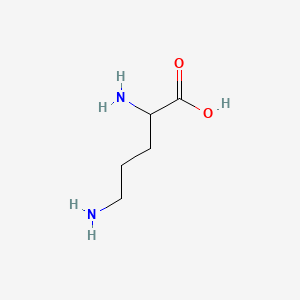| MeSH term | MeSH ID | Detail |
|---|---|---|
| Malaria, Vivax | D016780 | 2 associated lipids |
| Central Nervous System Bacterial Infections | D020806 | 1 associated lipids |
2,5-diaminopentanoic acid
2,5-diaminopentanoic acid is a lipid of Fatty Acyls (FA) class. The involved functions are known as Vasodilation, Intestinal Absorption and Pinocytosis. 2,5-diaminopentanoic acid often locates in Mitochondria, Microfilaments, NADH dehydrogenase complex and respiratory chain complex III location sensu Eukarya. The associated genes with 2,5-diaminopentanoic acid are GAPDH gene and iberiotoxin.
Cross Reference
Introduction
To understand associated biological information of 2,5-diaminopentanoic acid, we collected biological information of abnormalities, associated pathways, cellular/molecular locations, biological functions, related genes/proteins, lipids and common seen animal/experimental models with organized paragraphs from literatures.
What diseases are associated with 2,5-diaminopentanoic acid?
There are no associated biomedical information in the current reference collection.
Possible diseases from mapped MeSH terms on references
We collected disease MeSH terms mapped to the references associated with 2,5-diaminopentanoic acid
PubChem Associated disorders and diseases
What pathways are associated with 2,5-diaminopentanoic acid
There are no associated biomedical information in the current reference collection.
PubChem Biomolecular Interactions and Pathways
Link to PubChem Biomolecular Interactions and PathwaysWhat cellular locations are associated with 2,5-diaminopentanoic acid?
Visualization in cellular structure
Associated locations are in red color. Not associated locations are in black.
Related references are published most in these journals:
| Location | Cross reference | Weighted score | Related literatures |
|---|
What functions are associated with 2,5-diaminopentanoic acid?
Related references are published most in these journals:
| Function | Cross reference | Weighted score | Related literatures |
|---|
What lipids are associated with 2,5-diaminopentanoic acid?
There are no associated biomedical information in the current reference collection.
What genes are associated with 2,5-diaminopentanoic acid?
Related references are published most in these journals:
| Gene | Cross reference | Weighted score | Related literatures |
|---|
What common seen animal models are associated with 2,5-diaminopentanoic acid?
There are no associated biomedical information in the current reference collection.
NCBI Entrez Crosslinks
All references with 2,5-diaminopentanoic acid
Download all related citations| Authors | Title | Published | Journal | PubMed Link |
|---|---|---|---|---|
| Kobylarz MJ et al. | Deciphering the Substrate Specificity of SbnA, the Enzyme Catalyzing the First Step in Staphyloferrin B Biosynthesis. | 2016 | Biochemistry | pmid:26794841 |
| Gomig F et al. | Quinolone resistance and ornithine decarboxylation activity in lactose-negative Escherichia coli. | 2015 Jul-Sep | Braz. J. Microbiol. | pmid:26413057 |
| Jegatheesan P et al. | Citrulline and Nonessential Amino Acids Prevent Fructose-Induced Nonalcoholic Fatty Liver Disease in Rats. | 2015 | J. Nutr. | pmid:26246323 |
| Zhang X et al. | High-level expression of human arginase I in Pichia pastoris and its immobilization on chitosan to produce L-ornithine. | 2015 | BMC Biotechnol. | pmid:26227111 |
| LeMoine CM and Walsh PJ | Evolution of urea transporters in vertebrates: adaptation to urea's multiple roles and metabolic sources. | 2015 | J. Exp. Biol. | pmid:26085670 |
| Sakanaka A et al. | Arginine-Ornithine Antiporter ArcD Controls Arginine Metabolism and Interspecies Biofilm Development of Streptococcus gordonii. | 2015 | J. Biol. Chem. | pmid:26085091 |
| Horibata S et al. | Utilization of the Soft Agar Colony Formation Assay to Identify Inhibitors of Tumorigenicity in Breast Cancer Cells. | 2015 | J Vis Exp | pmid:26067809 |
| AbdElgawad H et al. | Grassland species differentially regulate proline concentrations under future climate conditions: an integrated biochemical and modelling approach. | 2015 | New Phytol. | pmid:26037253 |
| Coutelier M et al. | Alteration of ornithine metabolism leads to dominant and recessive hereditary spastic paraplegia. | 2015 | Brain | pmid:26026163 |
| Zou XY et al. | Glyoxalase I is differentially expressed in cutaneous neoplasms and contributes to the progression of squamous cell carcinoma. | 2015 | J. Invest. Dermatol. | pmid:25184957 |
